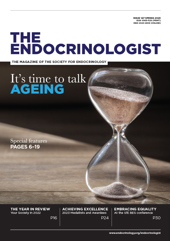The management of type 1 diabetes (T1DM) has traditionally focused on the younger individual, partly due to the long-held consideration that this autoimmune disease will present in a younger cohort. Even key trials (such as the Diabetes Control and Complications Trial; DCCT) tend to have a younger cohort, making generalisability to older populations difficult, leading to a relative dearth of high quality evidence in this cohort.
Though the peak age at which T1DM is diagnosed is relatively young, it is known that it can and has been diagnosed across a broad age range, with prevalence highest in those who are 35–60 years of age.1 The number of people older than 65 years with diabetes has been projected to reach 195.2 million by 2030 and 276.2 million by 2045.2
Additionally, with greater awareness and priority focus in national frameworks, as well as therapeutic and management options for care, more and more people with T1DM are living longer. This highlights the need to consider the older adult with T1DM, and the management of diabetes in settings of more common co-morbidities in this age group, such as frailty and cognitive decline.
FRAILTY
Traditional definitions of ‘old’ based on chronology have long been discarded, as we are all aware that ‘age is but a number’ and does not define the individual. This is where the concept of frailty has gained prominence. Frailty is defined as ‘a distinctive health state related to the ageing process in which multiple body systems gradually lose their in-built reserves’.3 It is important to recognise frailty, because it has been shown to increase the risk of poorer health outcomes, including hospitalisation and mortality.4
In the setting of diabetes, there is a paucity of data looking at those with T1DM and frailty. There is more evidence in the setting of type 2 diabetes (T2DM), given the older cohort. Diabetes has been shown to be a risk factor for the development of frailty, and there is some evidence suggesting that improved glycaemic control may reduce the severity of frailty. However, the key intervention has been shown to be exercise, specifically resistance training.5
Recent changes to guidelines highlight the need to consider several factors when examining targets in those with frailty, and adapting the ‘individualised approach’ so often mentioned in the management of people with diabetes. There have also been consensus discussions on frailty and intensification and de-escalation of therapy. However, these tend to focus on T2DM.6 The management of T1DM in this setting, though following similar principles, tends to be limited, due to the need for insulin therapy. Considerations around hypoglycaemia reduction, by reducing insulin requirements but not cessation of therapy, are key to avoiding hypoglycaemia risk, without increasing the risk of rebounding hyperglycaemia or diabetic ketoacidosis.7
COGNITIVE IMPAIRMENT
Another important area to consider is the development of cognitive impairment in those with T1DM. Diabetes is an established risk factor for dementia, with a roughly twofold increased risk.8 There are many possible reasons for the link between diabetes and dementia. Vascular disease and cerebral ischaemia, as well as a higher risk of stroke, could lead to cognitive impairment as, indeed, does exposure to higher levels of glycated haemoglobin (HbA1c). It may be argued that cognitive impairment is a chronic complication of diabetes.
Hypoglycaemia is an interesting and important consideration in the setting of cognitive impairment. There has been conflicting evidence as to whether hypoglycaemia is causative of chronic cognitive impairment, with the DCCT–Epidemiology of Diabetes Interventions and Complications (EDIC) Trial showing no worsening of cognition in those with severe hypoglycaemia (SH) over an 18-year follow up. This was superseded by a 32-year follow up, which revealed that higher exposure to HbA1c and SH was linked to poorer cognitive scores.9 Further data in T1DM from the Study of Longevity in Diabetes (SOLID) Study also showed that SH was associated with poorer cognition.10
This lends further support for why SH (and hypoglycaemia in general) should be avoided both in older adults, to prevent cognitive decline, and also in those with cognitive impairment, to prevent worsening cognition. The situation is complicated by the fact that many will be unable to recognise hypoglycaemia, nor will it be identified, due to the difficulty for third parties of recognising the change in baseline/confusion. A higher index of suspicion and education is therefore warranted.
FUTURE CONSIDERATIONS AND IMPLICATIONS
Given the challenges in clinical management and the historically limited evidence base, it is imperative that older adults with T1DM are considered in future guidelines, policies and research studies.
'Diabetes has been shown to be a risk factor for the development of frailty, and there is some evidence suggesting that improved glycaemic control may reduce the severity of frailty.'
Practically, whilst the use of technology has been well established in many areas, the opportunities for the use of continuous glucose monitoring systems in frail older adults or those with cognitive impairment need further exploration. The presence of hybrid closed loop systems also invites consideration of whether stricter glycaemic control without increasing hypoglycaemia risk might result in changes to glycaemic targets in older adults.
Beyond this, research around appropriate targets, multimorbidity and complication risk in older adults would aid understanding and support of those in this group.
As can be seen, the importance of understanding how management differs and the clinical considerations for older adults is paramount for all those who care for people with diabetes, especially those with T1DM. Given the longer modern life expectancy, healthcare professionals and systems need to proactively learn and plan for this.
AMAR PUTTANNA
Consultant in Diabetes and Endocrinology, West Midlands
National Advisor for NHS Engagement at Sanofi UK
REFERENCES
1. NICE 2023 Diabetes – Type 1: How Common Is It?
2. Sinclair A et al. 2020 Diabetes Research & Clinical Practice 162 108078.
3. British Geriatrics Society 2023 Frailty Resources.
4. Xue QL 2011 Clinics in Geriatric Medicine 27 1–15.
5. Lee J et al. 2017 Diabetes Therapy 8 459–473.
6. Strain WD et al. 2021 Diabetes Therapy 12 1227–1247.
7. Sinclair AJ et al. 2020 Diabetic Medicine 37 53–70.
8. Biessels GJ & Despa F 2018 Nature Reviews Endocrinology 14 591–604.
9. Jacobson AM et al. 2021 Lancet Diabetes & Endocrinology 9 436–445.
10. Lacy ME et al. 2020 Diabetes Care 43 541–548.







